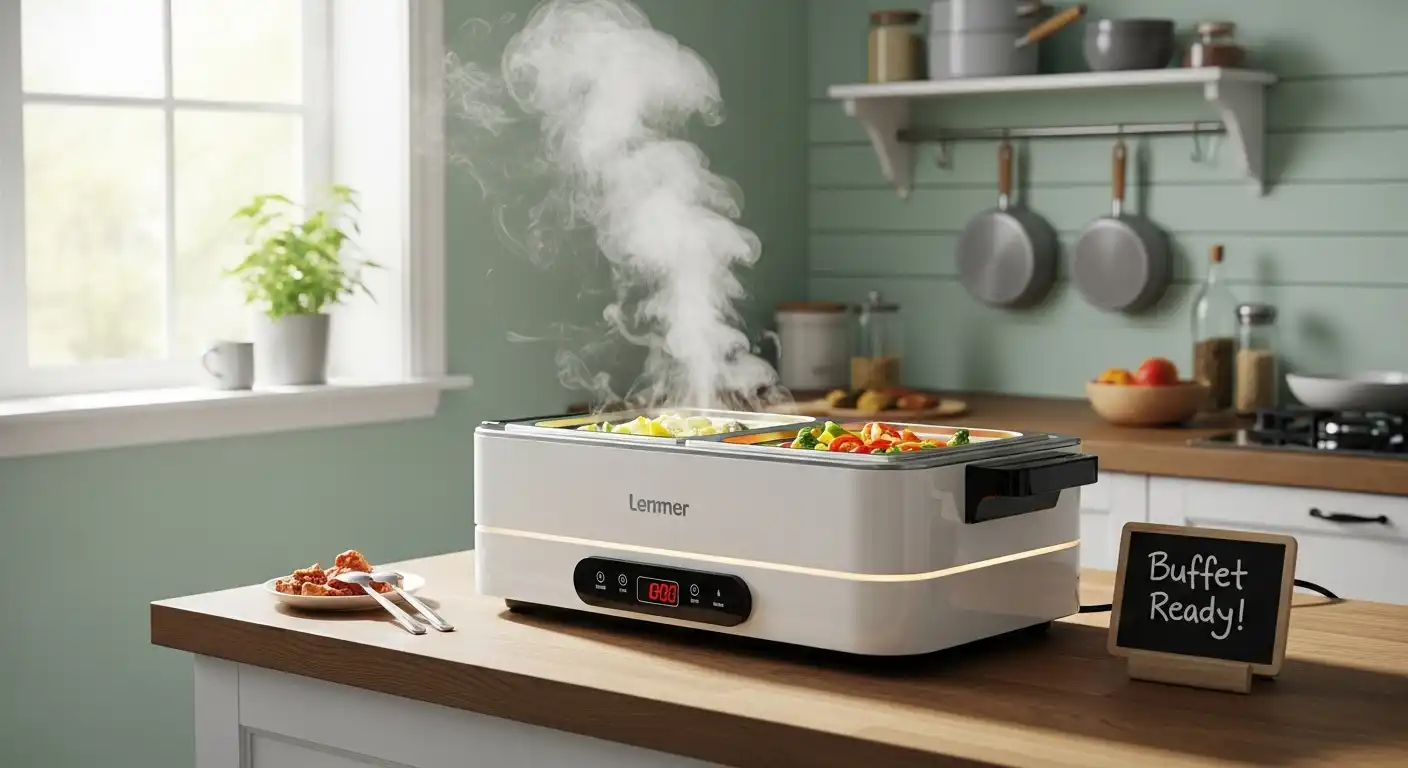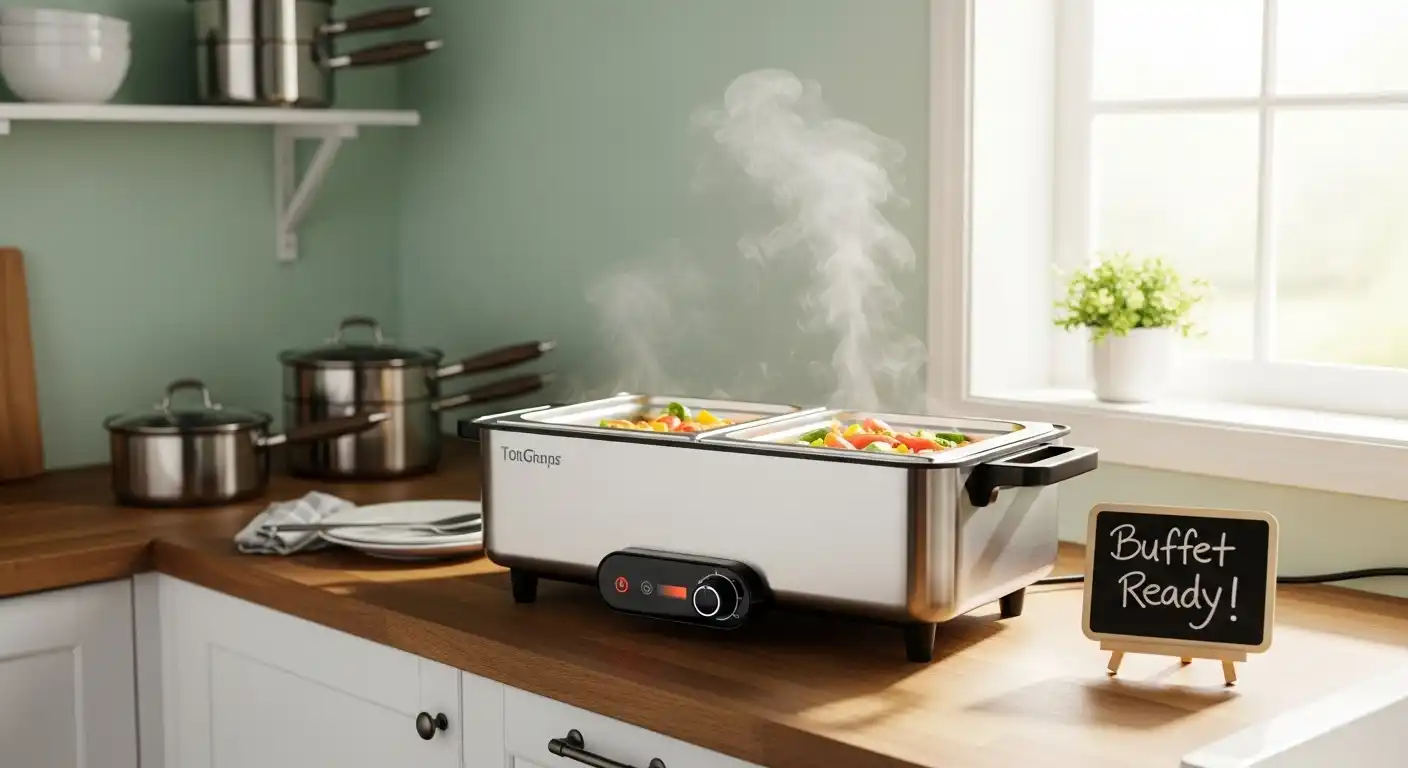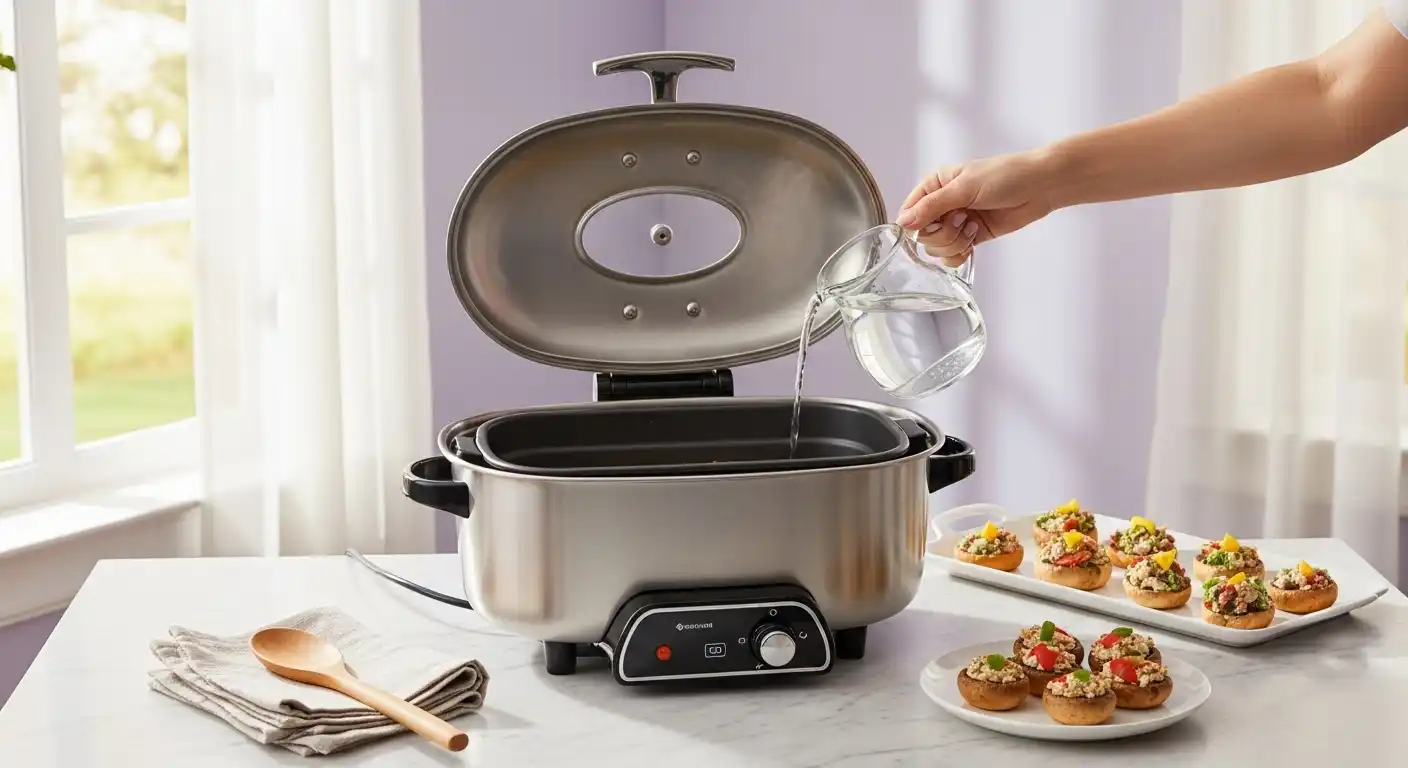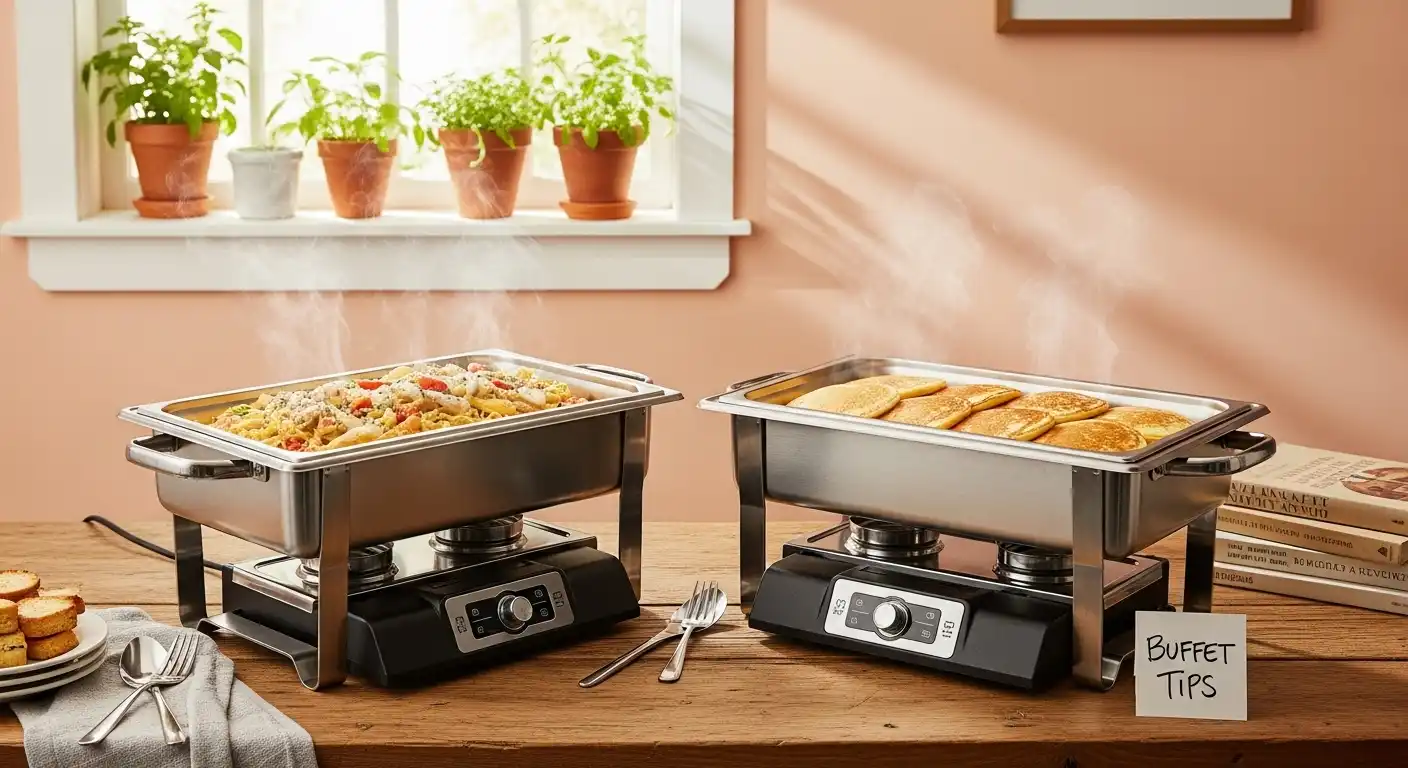Do You Put Water in an Electric Chafing Dish?

Electric chafing dishes are a staple for buffet-style events, keeping food warm and appetizing for hours.
But a common question arises: Do you put water in an electric chafing dish?
Unlike traditional fuel-based chafing dishes, electric models operate differently, and understanding their mechanics can ensure your food stays perfectly warm without compromising safety or quality.
In this post, we’ll explore whether water is necessary for electric chafing dishes, how they work, and tips for using them effectively.
🎄 Christmas & Year-End Amazon Deals !
Don’t miss out on the best discounts and top-rated products available right now!
*As an Amazon Associate, I earn from qualifying purchases.
Whether you’re hosting a wedding, a corporate event, or a family gathering, this guide will help you make the most of your electric chafing dish.
How Do Electric Chafing Dishes Work?

Electric chafing dishes use a heating element to warm the food pan directly, eliminating the need for an open flame.
The design typically includes a food pan, a base, and a temperature control system.
Unlike traditional chafing dishes that rely on chafing dish fuel, electric models plug into an outlet and provide consistent, adjustable heat.
This makes them safer and more convenient for indoor events.
But does this mean water is unnecessary? Let’s dive into that next.
Do You Put Water in an Electric Chafing Dish?
The short answer is: it depends on the model.
Some electric chafing dishes are designed to use a water pan, similar to traditional chafing dishes, while others heat the food pan directly without water.

For models with a water pan, a small amount of water is placed in a compartment below the food pan.
The heating element warms the water, creating steam that gently heats the food.
This method is ideal for keeping delicate foods, like sauces or vegetables, moist and preventing them from drying out.
However, many modern electric chafing dishes are “dry heat” models.
These use a heating element to directly warm the food pan, eliminating the need for water.
Dry heat models are often preferred for foods like pancakes or pizza, which don’t benefit from steam.
🎄 Christmas & Year-End Amazon Deals !
Don’t miss out on the best discounts and top-rated products available right now!
*As an Amazon Associate, I earn from qualifying purchases.
Always check the manufacturer’s instructions for your specific model to confirm whether water is required.
Using water in a dry heat model could damage the unit, while skipping water in a steam-based model might result in uneven heating.
Benefits of Using Water in an Electric Chafing Dish
For models that require water, there are several advantages to this setup:
- Consistent Heat Distribution: The steam created by the water ensures even heating, preventing hot spots that could burn food.
- Moisture Retention: Steam keeps food like rice, pasta, or vegetables from drying out, maintaining their texture and flavor.
- Temperature Control: Water acts as a buffer, preventing the food from overheating, which is especially useful for delicate dishes.
If your electric chafing dish uses a water pan, you’ll typically need about 1-2 inches of water, depending on the size of the pan.
For precise guidance, check out how much water to put in a chafing dish.
When Water Isn’t Necessary
Dry heat electric chafing dishes are becoming increasingly popular due to their simplicity.
Since they don’t require water, they’re easier to set up and clean. These models are ideal for foods that don’t need added moisture, such as bread or fried items like fish and chips.
However, dry heat models may not be suitable for all dishes. Foods that benefit from moisture, like creamy casseroles, may dry out without a water pan.
Always consider the type of food you’re serving when choosing your chafing dish.
For more details on waterless operation, see can you use a chafing dish without water.
How to Use an Electric Chafing Dish Properly
To get the best results from your electric chafing dish, follow these steps:
- Read the Manual: Confirm whether your model requires water. If it does, fill the water pan to the recommended level.
- Preheat the Dish: Allow the chafing dish to heat up for 10-15 minutes before adding food. Learn more about how long to heat chafing dishes.
- Use the Right Pan Size: Ensure the food pan fits properly to avoid heat loss. Check what size foil pan for chafing dish for guidance.
- Monitor Temperature: Adjust the temperature based on the food type. Most electric chafing dishes allow settings between 120°F and 200°F.
- Refill Water if Needed: For water-based models, check the water level periodically to prevent it from running dry.
Proper use ensures your food stays warm and safe. For a complete guide, visit how to use a chafing dish.
🎄 Christmas & Year-End Amazon Deals !
Don’t miss out on the best discounts and top-rated products available right now!
*As an Amazon Associate, I earn from qualifying purchases.
Common Mistakes to Avoid
Using an electric chafing dish is straightforward, but there are pitfalls to watch out for:
- Overfilling the Water Pan: Too much water can overflow and damage the heating element. Stick to the recommended amount.
- Using Water in a Dry Heat Model: This can cause electrical issues or uneven heating. Always verify your model’s requirements.
- Neglecting Cleaning: Food residue or water scale can build up over time. Learn the best way to clean a chafing dish to keep it in top shape.
By avoiding these mistakes, you’ll extend the life of your chafing dish and ensure safe operation.
Choosing the Right Electric Chafing Dish

Not all electric chafing dishes are created equal. When selecting one, consider:
- Water vs. Dry Heat: Decide based on the types of food you’ll serve most often.
- Capacity: Ensure the dish can hold enough food for your event. Check how much food an 8 qt chafing dish holds for reference.
- Portability: If you’re hosting events at different locations, look for lightweight models that are easy to transport.
- Durability: High-quality materials ensure longevity. See how long do chafing dishes last for tips on choosing a durable option.
For a detailed guide, read how to choose the electric chafing dish.
Safety Tips for Electric Chafing Dishes
Safety is paramount when using any electric appliance. Here are some key tips:
- Check the Cord: Ensure the power cord is in good condition to avoid electrical hazards.
- Avoid Overheating: Don’t leave the chafing dish on high for extended periods, especially with dry heat models.
- Store Properly: When not in use, store your chafing dish correctly to prevent damage. Learn more at how to store chafing dishes.
By following these precautions, you can enjoy worry-free hosting.
Can You Cook in an Electric Chafing Dish?
While chafing dishes are primarily designed to keep food warm, some users wonder if they can cook food in a chafing dish.
Electric models with adjustable temperature settings can sometimes be used for gentle cooking, like simmering sauces, but they’re not a substitute for a stovetop or oven.
For reheating, check out can you reheat food in a chafing dish for best practices.
How Long Can Food Stay in an Electric Chafing Dish?
Electric chafing dishes can keep food warm for several hours, but food safety is crucial.
Most foods should not stay in a chafing dish for more than 4 hours to avoid bacterial growth. For detailed guidelines, see how long can food stay in a chafing dish.
Regularly check the temperature to ensure it stays above 140°F, the safe zone for hot food. Learn more about how hot chafing dishes keep food.
🎄 Christmas & Year-End Amazon Deals !
Don’t miss out on the best discounts and top-rated products available right now!
*As an Amazon Associate, I earn from qualifying purchases.
Final Thoughts
Electric chafing dishes are a game-changer for keeping food warm at events, but whether you need to put water in them depends on the model.
Water-based models use steam for gentle, even heating, while dry heat models offer simplicity and versatility.
By understanding your chafing dish’s requirements and following best practices, you can ensure your food stays delicious and safe for guests.
Ready to elevate your next event? Explore the best chafing dish buffet sets or consider renting chafing dishes for a hassle-free option. With the right setup, your buffet will be the talk of the town!
